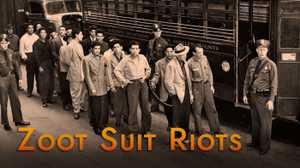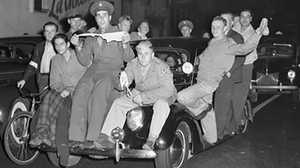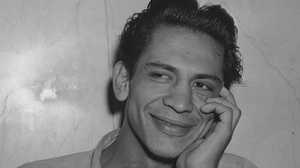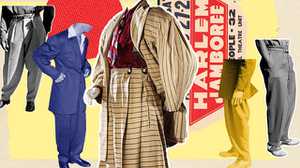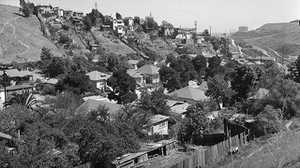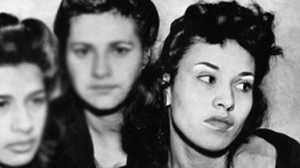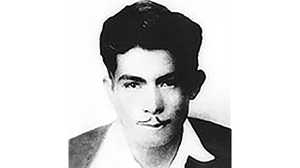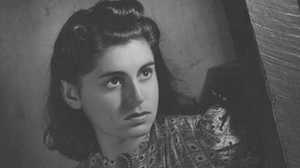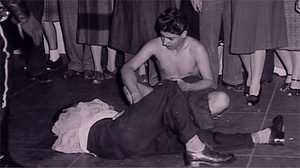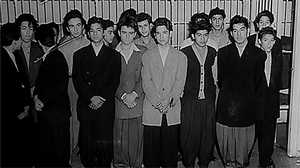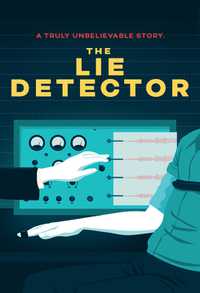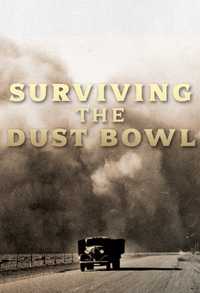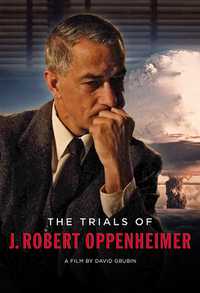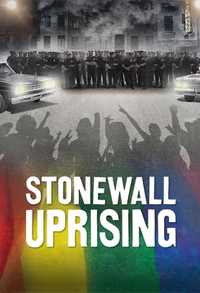Narration
On a clear night in August of 1942, a group of Mexican American teenagers from LA's 38th street headed to a swimming hole called Sleepy Lagoon.
Riding in the car was Hank Leyvas. Earlier that evening Hank and his girlfriend had been beaten by Mexican American kids from another neighborhood. Hank was determined to defend his sweetheart’s honor.
As they approached Sleepy Lagoon, the sounds of a party filtered through the trees… and Hank Leyvas thought he had found the boys he was looking for.
The ten-minute fight at Sleepy Lagoon had all the markings of a typical teenage rumble…except for what neighbors discovered later that night.
In the light of the full moon, Jose Diaz, a twenty-two year-old about to go off to war, lay dying. He had been beaten and stabbed.
Edward Escobar, Historian
“During the summer of 1942, there had been growing concern about Mexican-American youth crime. “
[10:13:42] ” when the Sleepy Lagoon case broke, and Jose Diaz’s body was found… “
“it came at exactly the right moment for the hysteria to erupt. “
Narration
In the 1940’s, one Mexican kid killing another didn't attract much interest from authorities. But in war-time Los Angeles Jose Diaz’s murder would play out differently. The police department stormed the city’s Mexican American community.
Hank Leyvas was the main suspect.
The arrest and trial of Leyvas and others from the 38thSt. neighborhood raised fears that Mexican youth were out of control.
Within months the city would be gripped by brutal racial rioting…
Mexican Americans would point to the riots of 1943 as the darkest days of their long history in the City of the Angels.
Zoot Suit Riots
Act I
Narration
In 1942 the mood in the city of the angels was eerie. The country was at war. On the streets, the talk was of spies and traitors. Suspicions swirled around young Mexican Americans. Fears abounded that rebellious kids were being manipulated by enemy agents.
George Sanchez, Historian
“In the local papers, you saw often columns right next to each other. [12:28:22] Japan is doing this. Our local threat is these Mexican-American youth. “
Narration
Less than a hundred years before, Los Angeles belonged to Mexico. Business was conducted in Spanish…and streets had names like Eternidad and Chapule. But by 1942, Nuestra Senora de Los Angeles was now simply Los Angeles…and more than just the name of the city had changed. Chapule became Pearl St. and Eternidad became Broadway. As Los Angeles grew, Mexican Americans came to be viewed as foreigners in a city established by their ancestors.
Within 48 hours of Jose Diaz’s murder, six hundred young Mexican Americans were caught in a dragnet.
Lupe Leyvas, Sister
“They picked up everybody that was over 12, and up to 25. You couldn't walk out on the street, because they would take you. So the word went out in the neighborhood "They're picking up everybody. And it's about a fight. And it's about somebody got killed." Then, the parents would go to the other parents and tell them "Look, they're doing this and that. Keep the kids in the house." we were just peeking out the windows. Police were all over the streets.”
Edward Escobar, Historian
“The police did regularly harass Mexican kids on the street because they thought of them as being the criminal element. If the kid just looks suspicious, they would pick them up. If the kid looked sullen or didn't give proper respect, that kid could get beat up by the police. There are a number of instances in which Mexican kids said, you know, if you're on the street after 8 o'clock, just be careful. You've got to get off the streets.”
Narration
Hank Leyvas was no stranger to the LAPD. Leyvas was routinely picked up by police when the suspect of a crime was ambiguously described as an “unknown Mexican.”
Eduardo Pagan, Historian
“From the perspective of the LAPD, Henry was a delinquent with a chip on his shoulder, largely because he was the kind of kid who would stand up for his rights. He would protest assaults upon him. He would protest if he was arrested, for example. He would challenge them.”
Narration
By the summer of 1942 his life seemed headed in a new direction. He had enlisted in the Merchant Marine, even been issued a uniform. But now he was a suspect in the murder of Jose Diaz.
Lupe Leyvas, Sister
“As soon as we pulled up, my mother started to get out of the car and the police surrounded the car, and they arrested my brother.
I asked them, "Where are you taking him?" and they said "To the 77th Police Station.”
Narration
Decades of discrimination had forced the Mexican American community to turn inward. By the 1940’s LA’s 250,000 Mexican Americans lived in a series of tight-knit neighborhoods called barrios. The communities were traditional, conservative, and self-contained. But like many Mexican Americans of his generation Hank Leyvas refused to accept the confines of the barrio.There was a different America outside their neighborhood and Hank and others like him wanted to claim a piece for themselves.
George Sanchez, Historian
"The tensions that arose from this sort of splitting of culture, is that often parents really saw their children disappearing from them. From the sanctity of the barrio, from the cultural world. Even though physically they remained, they more often were the people that would venture into various aspects of American culture.”
Eduardo Pagan, Historian
"These kids spoke to each other in English. And it was an English that was punctuated by jazz phrases; "cool", "hip", "on time.” All of these kinds of things that they very clearly drew from the jazz culture during this period.”
"And some of the boys from 38th Street will tell you they had no Spanish during this time. They didn't speak Spanish."
Narration
The wartime economy put money in the kids’ pockets. In 1942 they were spending it on big ballooned pants, pegged at the ankle and long baggy coats; a style borrowed from African Americans, it was called the zoot suit. The zoot-suit was everywhere. In the night clubs kids in zoot-suits ruled the dance floor. Their stoic moves…the essence of LA cool.
Art Arenas
“All they do is get the girl’s arm like that, and she go around him, and he put his arm out this way, and then she’d go around about three times, and he go like that, because that guy was not going to move.”
“…he didn't want to wrinkle the coat or nothing.”
“…he don't want to mess up his pants.”
Eduardo Pagan, Historian
“As soon as they would get out of the house they would beeline straight down to Central Avenue where a lot of jazz clubs were. And they would go there to listen to jazz artists, and to dance the swing. And all of these things that their Mexican parents would probably not have approved of. And they found ways of sneaking around. And in fact, wearing the zoot suit, I would say, was part of that.”
Lupe Leyvas, Sister
"Many times I wore my skirt just above my knee until I got around the corner, then I'd roll it up at the waste, and so that it would be really short. Then coming back from school, we'd just pull them down.”
"The boys wore their pants very wide at the knee...They were always to be 40 inches at the knees, and 10 to 11 inches at the cuff, so they were very ballooned out, very high wasted.”
Narration
Their outrageous clothes and cocky attitudes shocked their traditional parents who feared their sons and daughters were becoming pachucos.
Eduardo Pagan, Historian
“In Los Angeles in the early forties, the word "pachuco" meant punk. These were ill-mannered kids. These weren't the kids that you wanted your children to hang out with.”
Narration
Many white Los Angelenos felt threatened by their assertive presence. To them, any Mexican kid in a zoot suit was a potential pachuco…
Eduardo Pagan, Historian
“…by wearing their zoot suits, and swaggering down the streets in public, these kids defied the norms of segregation”
"It's hard for us to imagine, but to go back in the context in the 1940s when everything around you told you you're not one of us. You're not American. And because you're not American, because you're not white, you're supposed to remain in your neighborhoods. You can't go to our clubs. You can't go to our restaurants. You can't go to our movies, and on, and on, and on. And of course that’s going to breed some sort of resentment.”
Narration
The tension on LA’s streets was heightened by the presence of 50,000 sailors looking for a way to let off steam before heading off to war.
George Sanchez, Historian
“Well, the tensions between servicemen and Mexican-American boys I think came from a lot of different places. The first place to look is in terms of the servicemen's own backgrounds. Uh, a lot of these servicemen, uh, were coming from other parts of the United States. They were not familiar with Mexican-Americans. And they really were not accustomed to not only the diversity of Los Angeles, but the kind of interaction one would see on the city streets…"
Narration
The charged atmosphere sparked frequent street battles between sailors from the Naval Armory and Mexican American boys from the surrounding community called Chavez Ravine.
Eduardo Pagan, Historian
“I think many of the Mexican-American kids during this period came to terms with segregation by seeing their neighborhoods as their neighborhoods. They resented the presence of whites, particularly, if you can imagine, white military personnel during this period pumped up, uh, by boot camp, ready to go out, and lick the Japs, andlick the Nazis.”
Narration
The sailors making their way back from a night on the town had no alternative but to cut through a mostly Mexican-American neighborhood.
George Bray
“Going down that canyon from the armory, – Mexican kids would sit up there on the side of the hill as we were walking down the road there…”
“You never wanted to get caught by yourself as a sailor in that area, by going there, in one, single file. You’re asking for trouble. You’re really asking for trouble.”
Reno Sanetti
“At the base, they told us to go down to the sail shop and they sewed thirteen pennies in the back of our neckerchief, that if any of the Pachucos came after you, you'd take that neckerchief off and use it as a billy club. Thirteen pennies can give you quite a blow. And we all had that.”
Narration
Each fight provided an excuse for the next. Sailors insulted Mexican American teenagers and they in turn taunted the sailors. The police had their own problems with LA’s Mexican youth.
Edward Escobar, Historian
“During the war years, the LAPD felt frustrated. … they were losing their best and most experienced police officers to go off into the army and the navy, into the service. And in addition to that, they were faced with this new phenomenon of the zoot suiters.”
"You don't know how many times you heard that they were going to take their kid gloves off. They were going to deal with the zoot suiters, harshly now, that they wanted to really step forward and deal with what they saw as this criminal element in a very harsh manner."
Narration
Inside the interrogation room of the 77th precinct, Hank Leyvas could not have imagined what was in store for him. The Sleepy Lagoon case was playing out like a Hollywood movie. Hank was the villain. The ending to this story would surprise everyone.
Act II
Narration
The arrest of Leyvas and twenty-one other boys made front-page news. Hank and his friends did admit to engaging in a fight, but they denied killing Jose Diaz.They stuck to their story despite tough treatment by the police.
Henry Ynostrosa, Sleepy Lagoon Defendant
“They put gloves on so they won’t mark their hands up, you know? And just whip you. Just hit you all over. The body, the face, and everything. In the legs, kick you in the legs. Yes. And they were trying to get a confession.”
Lupe Leyvas, Sister
“We got to the police station, and I went up to the counter. And I asked if we could see my brother, Hank, that he had just been picked up, and what could we do? And the officer said; he looked it up. He said "Yes, he's the leader." I said "Well, I am not sure that you've got the right person, if you're calling him the leader." He said "No, we know who you want." He said "You want to see Hank." They opened the door, and I saw my brother, but I didn't even recognize him. They had him handcuffed, the hands were behind the chairs. He had his head down. His lip was hanging all below his chin. And I called to him, but he didn't lift his head up. He was knocked out. He said "Well, now you've seen him."
Narration
Hank claimed that one of the cops who beat him was Chief Clem Peoples. The Chief was the lead investigator on the Sleepy Lagoon case.
When the largest mass trial in California history began in October of 1942, Peoples was there, building a case against Hank and the boys in the courtroom and writing articles about Sleepy Lagoon in the pulp press.
Presiding over the case was the honorable Charles Fricke, a well-respected judge known as a law and order man.
Bill Shibley
“Dad used to talk about Fricke as a prosecutor’s judge. Judge Fricke, according to my father, would take his prosecutors aside over lunch hours and educate them on how to introduce evidence. Uh, he prided himself in knowing criminal law better than anybody. I think my father felt that he thought of himself as infallible and tended to look down at counsel and look down at people that he didn’t agree with.”
Narration
Overruling objections from the defense, Judge Fricke sat all the defendants together, isolating them from their lawyers.
Since their arrest the defendants had not been allowed to get haircuts or clean clothes. Defense attorneys requested that the defendants be permitted to clean up. Their request was denied. The Judge ruled that the boys’ appearance was relevant to the case.
Lupe Leyvas, Sister
That's the way they are, that's the way they have to be out here. He said "They wear long, duck tail hair, and no, we're not allowing them to take haircuts. So nothing was allowed, so naturally, they looked really bad.”
Alice Greenfield McGrath, Sleepy Lagoon Defense Committee
“The jury was looking at the defendants who sat in two rows of seats opposite them and their dislike of the defendants was palpable. They did not like those people they were looking at.”
Narration
Hank and the other boys looked like vagabonds, said one observer.
Lupe Leyvas, Sister
“They were no longer those young men that took their pride in their clothes. They didn't have that.”
Narration
Only Hank Leyvas grasped the significance of the trial… his conviction would send a message that the city had Mexican youth crime under control.
Rudy Leyvas, Brother, Hank Leyvas
“My brother Hank knew that he was going to be the one that they were going to zero in on. He was very aware of what was happening.”
Alice Greenfield McGrath, Sleepy Lagoon Defense Committee
“Hank was cast as the villain because both in personality and size — he was like larger than, than the others …”
Narration
The prosecution painted a picture of the 38th St group as ruthless killers, with Hank as their leader. When the 38th St. kids took the stand, they told a different story.
They said they were driving around that night looking for the boys who had attacked Hank and his girlfriend earlier that evening. As they approached the party…two of the girls found Jose Diaz lying in the shadows. He had been beaten and stabbed.
Eduardo Pagan, Historian
“Blood is streaming down from both sides of his face. There's blood coming also out of his mouth. He's breathing quite shallow. And this is when they find him. Already unconscious before the fight broke out.”
Narration
As the girls attended to Jose…Hank and his friends went on the attack.
When the brief fight broke up, the girls helping Jose were pulled away. One of the boys spotted Diaz on the ground and hit him. The defendants admitted that one of their group had struck Diaz but under oath, they denied any responsibility for his death.
Though never charged in connection with the murder, the girls from 38th St were portrayed in the press as every bit as dangerous as the boys.
Elizabeth Escobedo, U. of Washington
“It was plastered all over the papers that girls took part in this murderous foray the night that Jose Diaz was killed. And that was a huge part of the story, that women were actually on the streets fighting with boys..”
Narration
Eight girls were called to testify by the prosecution. One after another they refused to cooperate. One of them was Lorena Encinas. She knew who killed Jose Diaz, but she would not reveal her secret.
The trial dragged on for 3 months.
Hank Leyvas’s mother remained hopeful throughout the process.
Lupe Leyvas, Sister
“My mother always thought that because her son was not guilty, that no matter what they do, at the end they're going to be released because they didn't have anything to do with the killing.”
Narration
On January 12, 1943, the jury announced its verdict.
Alice Greenfield McGrath, Sleepy Lagoon Defense Committee
“When the jury came in and the verdict was read, the expression on the faces of the defendants were of horror.”
Lupe Leyvas, Sister
“The mothers were all huddled together there. I was there with them. Most of them didn't speak English. There was, I think, only two that spoke English.”
“So we were quickly trying to translate to them what had happened.”
Narration
Seventeen defendants were found guilty. Hank Leyvas was sentenced to life.
Rudy Leyvas, Brother
“Hank kind of expected that they would be found guilty. And he picked his head up. A lot of them just dropped their head down and looked to the floor. But he just picked his head up like he knew just what was coming. My brother Hank knew what was going to come.”
Henry Ynostroza, Sleepy Lagoon Defendant
“Some of the guys were in tears. Yes. Ya know, and me and Hank Leyvas would tell them, buckle up, you suckers, you men. Be a man. Stop crying. We were hurting, too. But we weren’t trying to show it. We were trying to be machos and all that. A lot of guys were crying.”
Narration
The boys were sent to San Quentin prison, 400 miles from home.
They weren’t the only ones who would do time. The girls from 38thSt. were taken from their families and made wards of the state. In a legal process that provided neither jury nor trial, they were sent away to an infamous reform school.
Elizabeth Escobedo, U. of Washington
“The Ventura School for Girls at this time is really a very repressive institution, one that's custodial and disciplinary procedures completely rival the state prisons of the time.”
“Young women would go to very drastic measures in order to escape going to the Ventura School for Girls because of its bad reputation. There were women at the juvenile hall who knew that they were going to be ultimately sentenced to the Ventura School and they were swallowing safety pins the night before in order to get out of it.”
Narration
With the secret she held, Lorena Encinas could have made a deal. But she refused. She gave birth to a son, Ted, while an inmate at the school.
Ted Encinas, Son of Lorena Encinas
“My mother's reason for being there was for the mere reason that she failed to cooperate with the courts and divulge the information that they wanted her to, to name all the names of the people involved.”
Narration
During all the time she served at Ventura, Lorena kept details about Jose Diaz’s murder to herself. Her son was taken from her soon after his birth.
Act III
Narration:
While the 38thSt. boys did time in San Quentin, prominent Los Angelenos were working to get them released.
Believing the boys had been railroaded, Communists, intellectuals and Hollywood celebrities like Orson Welles and Rita Hayworth, lent their names to the newly-formed Sleepy Lagoon Defense Committee.
Lupe Leyvas, Sister
“I went to the Beverly Hills Hotel they said I had to go speak. [ She said] "Bring some clothes, we'll pick you up." I went as I dressed, with my knee high white socks, and my very short black skirt and white blouse. They picked me up and we went to Rita Hayworth's house. And Rita Hayworth said "No, no, you can't wear that. You can get one of my dresses." And uh, my first formal belonged to Rita Hayworth.”
Narration
Political activists also joined the cause.
Alice McGrath, Sleepy Lagoon Defense Committee
“…we had professional people, we had educators, we had -- we had congressmen, we had a lot of union people.”
Narration
The committee’s efforts to portray the defendants as innocent victims paid off. Money to fund an appeal came in from across the country. Prominent members of the Committee visited the boys to reassure them they would not be forgotten.
Henry Ynostroza, Sleepy Lagoon Defendant
“And Anthony Quinn told us, don’t worry. We’re going to beat this on appeal. Yes. You were railroaded. Listen, I’m behind you guys.”
Narration
In the months following the trial the city grew more tense. Skirmishes between sailors and zoot suiters became a daily occurrence.
Marietta Lee
“The Pachucos would intimidate people. They would walk down the street, five abreast and if you walked around them they would laugh or stick their hand out and hit you. After a while you got, so you would go down the side streets instead of confronting them.”
“A lot of them were from Mexico. They didn’t speak English. They didn’t adhere to our laws. They weren’t even geared up for the war effort.”
Narration
On June 3, 1943 the city exploded.
Eduardo Pagan, Historian
“As a group of service personnel were passing a group of civilian youth, one young man raised his hand in a manner that one of the sailors thought was threatening. One of the sailors turned around, and grabbed the arm of the young civilian, and from that point the fight broke out. It seemed that both sides were primed for confrontation, and the street seemed to explode in a fight. In the process, the sailor had his jaw broken, he was knocked unconscious, and his buddies had to drag him back to the armory.”
Narration
Later that night, a group of sailors armed with belts and clubs left the Naval armory and headed downtown. The Zoot Suit Riots had begun.
George Bray
“We had a commanding officer.… And he told the guys, he said, "Okay, men." He said, "We've had it." So he -- so the guys from the armory, they got out the gun belts and wrapped them around their hands and down they went and cleaned up town.”
Art Arenas
“I was in the theater downtown and watching a movie. All of a sudden the lights went on, and you hear a lot of noise -- commotion, and a lot of guys yelling or something. Now you turn around and you see these servicemen, beating the heck out of all these Mexicans.”
Gloria Rios Berlin
“So, and there was a fight, not just with fisticuffs, but some of them had chains. So what I did is I dived underneath the counter and stayed there and, you know, protected myself because it became very wild. It was like a movie set.”
Narration
Among the victims in the theater were twelve and thirteen year old boys, beaten by American servicemen because of the clothes they wore.
George Bray
“A lot of them came back happy, a lot of the guys, the Americans. They came back happy.”
Narration
The following night, hundreds of sailors took the fight beyond downtown and into the heart of LA’s oldest Mexican neighborhood.
George Sanchez, Historian
“The servicemen would cross the river, and head into communities like Boyle Heights, and then other parts of East Los Angeles to seek out Mexican-American youth that were no longer ending up in downtown Los Angeles at theaters and bars. So as the riot played itself out, there had to be a lot more sort of search and destroy -- to use a military metaphor. And that's where you get the real movement into East Los Angeles.”
Narration
Once in the barrio, sailors broadened their attack beyond Mexican boys in zoot-suits. Any Mexican in their path was a potential target.
George Sanchez, Historian
“The way the riots developed is very much attached to what the notion of a zoot-suiter was. The notion of a zoot-suiter was always racialized, even though Mexicans were not the only people wearing zoot suits. So a riot that first was aiming atindividuals because of their dress becomes a more expansive sort of riot, aimed at a particular racial population; Mexican-Americans.”
Narration
It didn't take long for the kids from the barrios to organize and fight back.
Rudy Leyvas, Brother
“There was an alley behind this theater and a lot right next to it. And it was just jammed. So we was waiting, it was already getting dark. So then about 20, 20, 30 guys come out in the street sort of so when the sailors come they could see them. And as soon as they went out there here comes the truck loads, truck loads of sailors and civilians. And they, uh they let out a cry, there they are, there they are. And they came in. As they came in, once they got all the way in, we all came out …. I had myself, had a bat and I used it. And there was people hurt on both sides.”
Reno Sanetti
“We were fist-a-cuffing and you know, kicking and biting and scratching. And I got a couple of good blows that knocked me down. They took me back to the base and put me in sick bay overnight. And the next morning I went to doing my normal duties. But I had two good shiners.”
Carlos Espinoza
“At night time they came. At night time, right? At night time they came. So we just disappear, right? Disappear. But we found out that the best thing to do to get even with them is watch them on Whittier Boulevard, and when there was four or five guys riding, uh, in a car and we would follow them until they have to come to a Boulevard stop and there would be another car in front of them, wewould run out there, open one door, and start pounding the hell out of the driver’s door and get him out. And then beat the hell out of the guy, right?”
Narration
On the fifth day of the riots, 5,000 civilians showed up to assist the sailors.
Marietta Lee
“My brother was only fourteen years old. I was sixteen at the time, but I did drive. And we got my mother’s car and we went to El Toro and picked up Marines… Los Angeles was like a war zone and we had to do something about it. The Pachucos had just taken over….I felt that I was doing my share for the war effort.”
Narration
The kids fighting the sailors were not entirely on their own.
Rudy Leyvas, Brother
“There’s this man, I never knew, I never seen him before. And he says, are you guys coming to fight sailors? And I says, yeah. And he said, I have a car here, it’s full of gas. And at that time the gas was rationed. He says, it’s full of gas, take it, use it, when you get through just leave the keys in it, put it any place on Central Avenue and I will pick it up. And he says, all I want you to do is get one of them white guys for me.”
Narration
By week’s end, the Zoot Suit Riots were making headlines across the country. Thousands of marines, soldiers, and sailors from as far away as Las Vegas arrived in the City of the Angels, itching to clean up the town. Mexican American kids were overwhelmed. In a ritual repeated across the city, servicemen stripped them of their clothes and burnt the garments on the streets.
Eduardo Pagan, Historian
“The LAPD hangs back during this entire confrontation: about a week of rioting. Never taking the offensive in trying to stop the riot. And only showing up after the rioting servicemen have swept through an area. And they show up only to arrest the victims of riot, and throw them into jail.”
Reno Sanetti
“…the shore patrol would naturally come out right away, because they were patrolling like regular policemen. And they’d come to break up a fight and they'd take these Pachucos-- if they could catch them if they didn't run away -- you know, they'd catch them and throw them in the jeep and put them in the paddy wagon and take them to jail. With the sailors, they'd put us in the jeep, take us a couple of blocks away and tell us to get back to our ship or get back to the station.”
Carols Espinoza
“None of the sailors ever got arrested. You tell me one of the sailors that got arrested for beating the hell out of somebody, huh?”
George Sanchez, Historian
“Within four or five days, L.A. officials realize this could move us out of control. Out of control in a wartime society. It could in fact lead to much greater problems, if servicemen kept disobeying their superiors, and going down into these communities. And that’s why it stopped.”
Narration
On June 8, 1943 military authorities in consultation with civic leaders declared the city off-limits to servicemen. The rioting ended soon afterwards.
The following day the city council adopted a resolution banning the wearing of zoot suits on LA streets. Wearing the suit in public was punishable by a thirty-day jail term. Stores that sold the suits quickly moved to distance themselves from the style that had become a symbol of rebellion.
George Sanchez, Historian
“Mexican-American youth I think were taught in World War II that they could not simply choose by themselves the way that they would express themselves. They simply couldn't choose what they could wear. They simply couldn't choose who they could be. That this was not a society that allowed for that kind of freedom of expression for these particular youth. And that's a very painful lesson. It's a very painful lesson when one hears the rhetoric of Americans all, the rhetoric of American promise, open to all sorts of immigrants, all sorts of people.”
Narration
As the riots subsided, the governor ordered the creation of a citizens committee. Its charge was to investigate and determine the cause of the riots.
Ironically, prison life had sheltered the 38th St. boys from the worst mob violence in Los Angeles history. With Hollywood stars still working on their behalf, the kids got special treatment.
Henry Ynostroza, Sleepy Lagoon Defendant
“We used to have what the guards used to eat, their food. Not prison food. Their food. You know, steak, pork chops, milk, ice cream, cake everything.”
Narration
Unlike the other boys, Hank Leyvas refused to play along. His resistance to authority earned him a stint at California’s dreaded Folsom prison.
“The locking of the doors,” he wrote, left him with “a lonesome, empty feeling…. You are standing up to the iron door waiting for the guard to come along and take the count. Listening as his footsteps fade away in the distance. You realize that you are alone…”
As the months passed, Leyvas grew increasingly resentful.
Finally, in November of 1943, defense attorneys filed an appeal with the California Second District Court claiming their clients had been denied a fair trial.
A year passed before a decision was handed down. By this time, Hank and the others had been locked up for more than two years.
Alice Greenfield McGrath, Sleepy Lagoon Defense Committee
“I sent a telegram to San Quentin care of Henry Leyvas to tell all the guys, uh, saying appeal successful — I've forgotten what else it said, but I know it ended, oh,…what a wonderful morning.”
Henry Ynostroza, Sleepy Lagoon Defendant
“We couldn’t believe it at first. It was like a shock. And one of the guys told me, he says, you know this guy’s got a barrel of homemade brew buried in the ground. And we felt like celebrating. So we dug it up. And we got drunk that night in the barracks over there. And the officers came, you know. They weren’t officers, they were like supervisors. And the head guy, the warden told them, as long as they don’t fight nobody and don’t cause no problem, leave them alone. Leave them alone. And we drank that whole barrel, yeah.”
Narration
In October of 1944 Hank Leyvas and the other boys were set free.
Ever-defiant, Hank Leyvas walked out of the Los Angeles Hall of Justice wearing a zoot-suit.
The court ruled that Judge Fricke had committed serious errors in the trial and threw out the verdict—but the court did not clear the 38th St boys of the murder charge.
Although LA authorities declined to re-try the case, the Sleepy Lagoon murder haunted Hank and the others for life.
Lupe Leyvas, Sister
“It stopped him from going into the service, which is the thing that he wanted so bad. He had already signed into the Merchant Marine. He had already had a trial run. And he was in uniform. And uh, it didn't happen… All this happened and it just broke his future.”
Narration
Jose Diaz was dead and his killer got away with murder. Those who had information weren’t talking in 1942.
Judy Torres, Daughter of Lorena Encinas
“My mom did know who the murderer of Jose Diaz was, but she kept it to herself. And she refused to cooperate with the authorities…”
Narration
Decades passed before the truth emerged.Toward the end of her life, Lorena Encinas at last shared her secret about the Sleepy Lagoon.
Judy Torres, Daughter of Lorena Encinas
“My mother admitted to me that the reason that she kept that secret from the authorities was that it was her brother Louie, who was involved in the murder.”
“…She kept it to herself because she was not the type of person that would snitch, so to speak, on anyone else. And she also was trying to protect my Uncle Louie.”
Narration
Lorena claimed that her brother Louie was at the party before the 38th St kids arrived, but had been thrown out for causing problems.
Later that night as Jose Diaz and two companions left the party, they were met by an angry Louie Encinas and friends.
In the fight that followed Jose Diaz was stabbed and left to die.
A short time later Hank Leyvas and his friends arrived at the party.
Narration
Louie Encinas was picked up in the dragnet following the Sleepy Lagoon murder but was let go by police.
Years later, Encinas committed suicide.
Narration
In 1943 the citizens’ committee investigating the Zoot Suit Riots issued its report. It condemned the role played by the press and by the LAPD and determined race to be a central cause of the riots.
At the same time, the Mayor came to his own conclusion. “The riots,” he said, “were caused by juvenile delinquents.” Race was not a factor.
38thSt girls, Lorena Encinas
The Sleepy Lagoon Defense Committee was powerless to help the 38thSt. girls. They remained wards of the California Youth Authority until they reached 21 years of age.
Lorena Encinas died in 1991.
Narration
As Hank Leyvas and the other boys walked out of prison, a guard remarked, “They’ll be back.”He was right.
Hank Leyvas and many of the other boys grew tragically familiar with prison life.
Hank, the symbolic zoot suiter, died in an East LA bar in 1971.
The Sleepy Lagoon murder remains officially unsolved.
